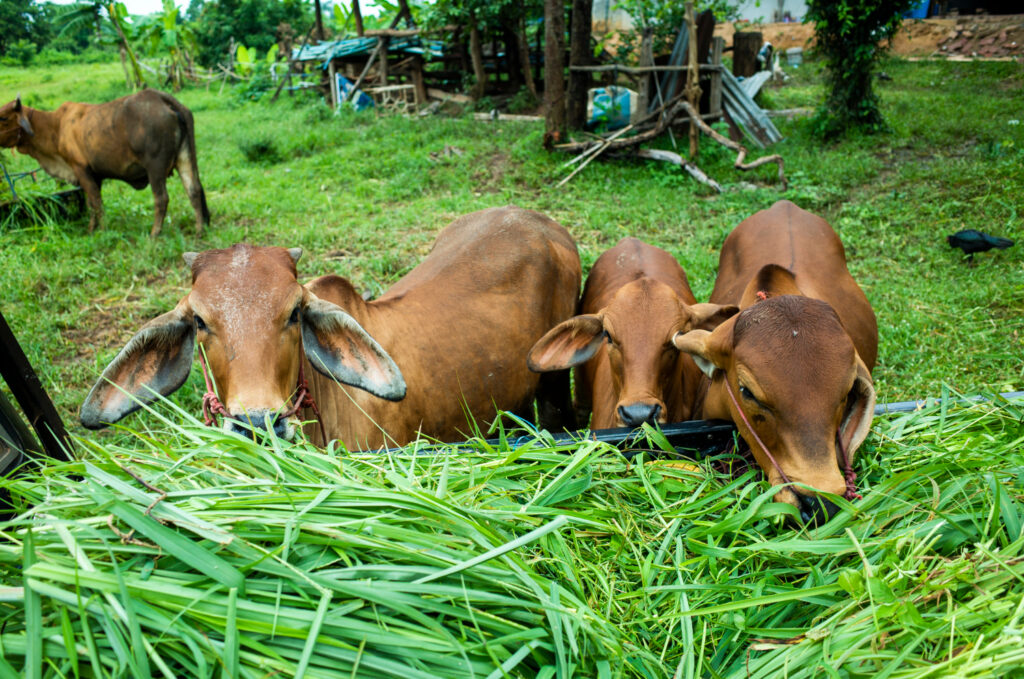In the world of livestock farming, the trend of miniature cows is gaining considerable attention. These pint-sized bovines, often dubbed “mini cows,” are capturing the hearts of farmers and hobbyists alike. But what exactly are miniature cows, and what makes them such a fascinating choice for breeders?
What are Miniature Cows?
Miniature cows, as the name suggests, are diminutive versions of traditional cattle breeds. They typically stand at around 36 to 48 inches tall at the shoulder, compared to standard cattle which can reach heights well over 60 inches. Despite their smaller stature, miniature cows maintain many of the characteristics of their larger counterparts, including milk and beef production capabilities.
Certainly! Here’s a structured response providing the average height, weight, and price for both male and female Dexter, Lowline Angus, Panda Cow, Miniature Zebu, and Miniature Hereford cows:
Breeds of Miniature Cows :
- Dexter
- Lowline Angus
- Panda Cow
- Miniature Zebu
- Miniature Hereford
Miniature Cows Average Height (in inches):
- Dexter: 36 – 42 (at the shoulder)
- Lowline Angus: 40 – 44 (at the shoulder)
- Panda Cow: 36 – 40 (at the shoulder)
- Miniature Zebu: 36 – 42 (at the shoulder)
- Miniature Hereford: 36 – 42 (at the shoulder)
Miniature Cows Average Weight (in pounds):
- Dexter: 600 – 800 (adult)
- Lowline Angus: 650 – 1,000 (adult)
- Panda Cow: 500 – 700 (adult)
- Miniature Zebu: 300 – 500 (adult)
- Miniature Hereford: 500 – 800 (adult)
Miniature Cows Average Price (per head):
- Dexter:
- Male: $800 – $1,200
- Female: $1,000 – $1,500
- Lowline Angus:
- Male: $1,200 – $2,000
- Female: $1,500 – $2,500
- Panda Cow:
- Male: $1,000 – $1,500
- Female: $1,200 – $1,800
- Miniature Zebu:
- Male: $600 – $1,000
- Female: $800 – $1,200
- Miniature Hereford:
- Male: $800 – $1,500
- Female: $1,000 – $1,800
These values can vary depending on factors such as age, bloodline, health, and the seller’s location. It’s always advisable to consult local breeders or agricultural authorities for the most accurate and up-to-date information.
Breeds of Miniature Cows :
Several breeds have been selectively bred to produce miniature versions. Among the most popular are:
1.Dexter :

Originating from Ireland, Dexter cattle are known for their small size and dual-purpose nature. They are prized for their high-quality beef and adaptability to various climates.
2.Lowline Angus:

Developed in Australia, Lowline Angus are a compact version of the traditional Angus breed. They possess excellent meat quality and are renowned for their docile temperament.
Panda Cow:

A relatively newer addition to the miniature cow scene, Panda cows are characterized by their distinctive black and white markings, reminiscent of their namesake. They are a crossbreed between Lowline Angus and Belted Galloway cattle.
Miniature Zebus:

Hailing from India, Zebu cattle are one of the oldest and smallest breeds of cattle. Miniature Zebus are prized for their heat tolerance and adaptability to harsh environments.
Miniature Hereford:

A downsized version of the traditional Hereford breed, Miniature Herefords are known for their docile nature and efficient meat production.
Why Choose Miniature Cows?
There are several reasons why breeders and farmers are turning to miniature cows:
- Space Efficiency: Miniature cows require significantly less space compared to their larger counterparts. This makes them ideal for small farms or hobbyist breeders with limited acreage.
- Lower Maintenance Costs: Due to their smaller size, miniature cows consume less feed and require fewer resources overall. This can result in substantial savings for farmers, particularly in feed and housing expenses.
- Ease of Handling: Their diminutive stature makes miniature cows easier to handle and manage, especially for those with limited experience in cattle farming.
- Dual-Purpose Potential: Many miniature cow breeds offer both meat and milk production capabilities, providing versatility for farmers seeking multiple revenue streams.
Benefits of Miniature Cows :
- Space Efficiency: Miniature cows require significantly less space compared to standard breeds, making them ideal for small farms, urban homesteads, or hobby farms with limited acreage.
- Feed Efficiency: Due to their smaller size, mini cows consume less feed and produce less waste, resulting in reduced feed costs and environmental impact.
- Ease of Handling: Their diminutive stature makes mini cows easier to handle, especially for novice farmers or those with physical limitations. Additionally, their docile temperament makes them suitable for children or individuals seeking gentle livestock.
- Diversification: Miniature cows offer farmers the opportunity to diversify their livestock portfolio, providing both meat and dairy products on a smaller scale. This diversification can enhance resilience against market fluctuations and cater to niche consumer demands.
References:
- “Dexter Cattle.” American Dexter Cattle Association. https://www.dextercattle.org/
- “About the Lowline Angus.” American Lowline Registry. https://www.lowlineangus.org/about-the-lowline-angus/
- “Miniature Panda Cow.” Miniature Panda Cow Association. https://www.minipandacow.com/
- “Miniature Zebu.” International Miniature Zebu Association. https://www.imza.name/
- “Miniature Herefords.” American Hereford Association. https://miniaturehereford.org/
In conclusion, miniature cows represent a unique and practical option for breeders and farmers seeking compact, efficient livestock. With a range of breeds to choose from and numerous benefits to consider, the miniature cow trend is likely to continue its growth in popularity within the agricultural community.









